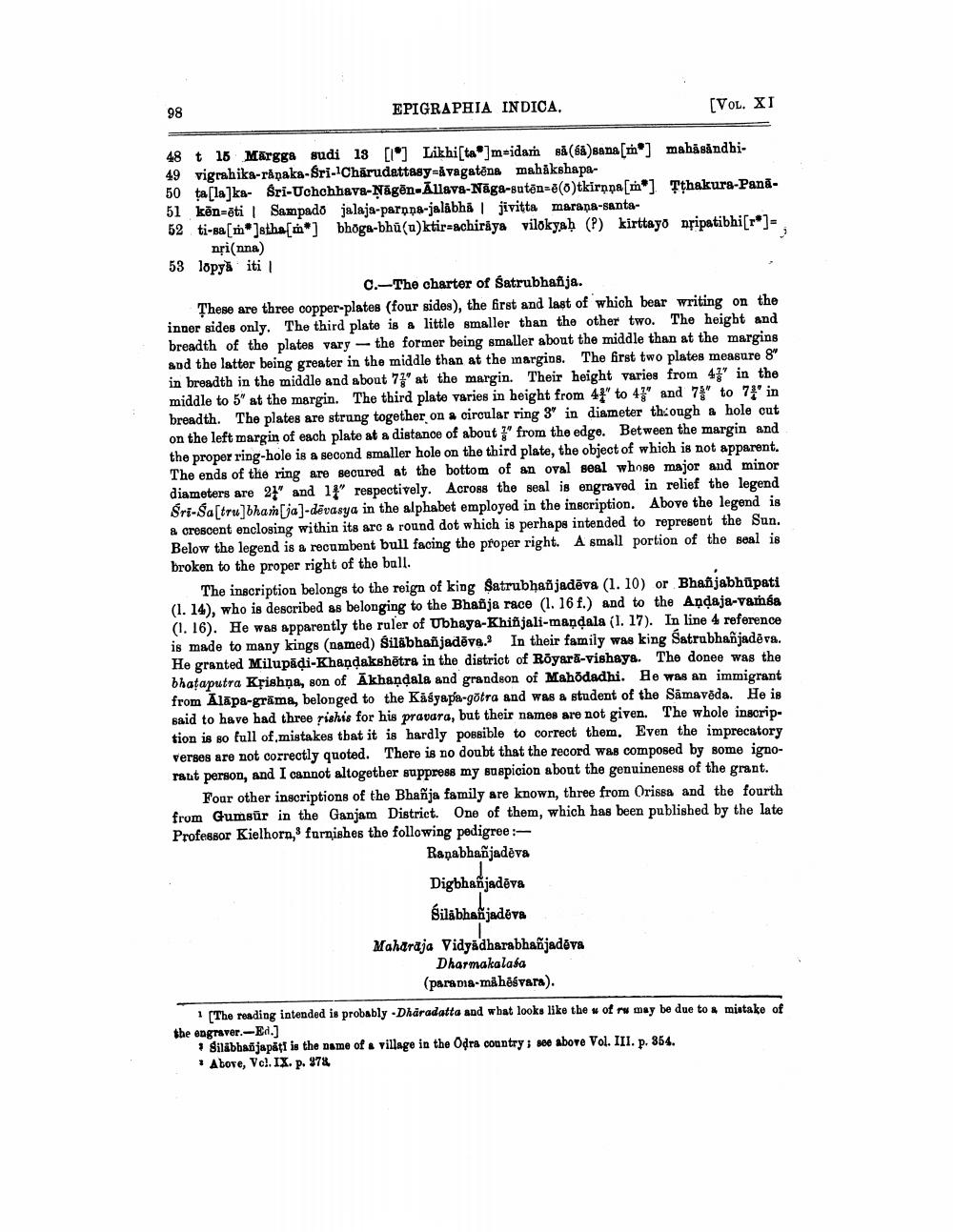________________
98
EPIGRAPHIA INDICA.
48 t 15 Margga sudi 13 [1] Likhi[ta]m-idam sa (sa)sana [m] mahasandhi49 vigrahika-rapaka-Sri-1Charudattasy-Avagatēna mahākshapa
50 ta[la]ka Sri-Uchchhava-Nagen-Allava-Naga-suten-e(o)tkirppa [m] Tṭhakura-Pana51 ken-ēti | Sampado jalaja-parppa-jalabha | jivitta marana-santa
62
-Jatham) banga-bha()ktir-achiriya vilokyab (?) kiritays ripatibi[r]= nri(nna)
53 lopyǎ iti |
[VOL. XI
C. The charter of Satrubhanja.
These are three copper-plates (four sides), the first and last of which bear writing on the inner sides only. The third plate is a little smaller than the other two. The height and breadth of the plates vary the former being smaller about the middle than at the margins and the latter being greater in the middle than at the margins. The first two plates measure 8" in breadth in the middle and about 73" at the margin. Their height varies from 43" in the middle to 5" at the margin. The third plate varies in height from 4" to 4" and 7" to 7" in breadth. The plates are strung together on a circular ring 3" in diameter though a hole cut on the left margin of each plate at a distance of about " from the edge. Between the margin and the proper ring-hole is a second smaller hole on the third plate, the object of which is not apparent. The ends of the ring are secured at the bottom of an oval seal whose major and minor diameters are 2" and 11" respectively. Across the seal is engraved in relief the legend Bri-Satrubha[ja]-dfeasga in the alphabet employed in the inscription. Above the legend is a crescent enclosing within its are a round dot which is perhaps intended to represent the Sun. Below the legend is a recumbent bull facing the proper right. A small portion of the seal is broken to the proper right of the ball.
The inscription belongs to the reign of king Satrubhañ jadeva (1. 10) or Bhañjabhupati (1. 14), who is described as belonging to the Bhañja race (1. 16 f.) and to the Anḍaja-vamsa (1. 16). He was apparently the ruler of Ubhaya-Khiñjali-maṇḍala (1. 17). In line 4 reference is made to many kings (named) Silabhañjadeva. In their family was king Satrubhañjadeva. He granted Milupadi-Khandakshetra in the district of Röyara-vishaya. The donee was the bhataputra Krishna, son of Akhandala and grandson of Mahodadhi. He was an immigrant from Alapa-grama, belonged to the Kasyapa-götra and was a student of the Samaveda. He is said to have had three rishis for his pravara, but their names are not given. The whole inscription is so full of,mistakes that it is hardly possible to correct them. Even the imprecatory verses are not correctly quoted. There is no doubt that the record was composed by some ignoraut person, and I cannot altogether suppress my suspicion about the genuineness of the grant.
Four other inscriptions of the Bhanja family are known, three from Orissa and the fourth from Gumsur in the Ganjam District. One of them, which has been published by the late Professor Kielhorn,3 furnishes the following pedigree:
Rapabbañjadera
Digbhajadeva
Sabbah jadva
Maharaja Vidyadharabhalijadora
Dharmakalasa (parama-mahêévara).
1 [The reading intended is probably -Dhäradatta and what looks like the u of ru may be due to a mistake of the engraver.-Ed.]
Siläbbañjapati is the name of a village in the Odra country; see above Vol. III. p. 354. Above, Vol. IX. p. 978




